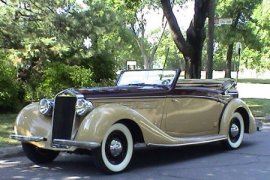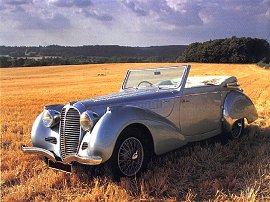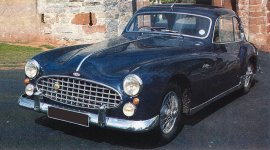
Beautiful, and conventional, the 1933 122 Berline
was the precursor to the wonderful 135...

The 1935 Delahaye 135 born from the genius of young
French designer Jean Francois...

This is the same car, from the same year as that
above it (1935 135 model). As can be seen, modifications
to cars built as "race specials"
was not confined to mere mechanicals...

The final iteration for the marque, the 1951 235
used a sweet 3.5 litre six encased in beautiful
bodywork. It would only remain in production for
3 short years... |
Today Delahaye is not only a lost marque, it could
also be described as a forgotten one. Ask someone to
name the lost French marques of last century and they
will invariably mention better known competitors of
Delahaye, such as Lorraine, Delage and of course the
wonderful Bugatti.
Emile Delahaye started business back in 1895, building
his first vehicle, although for some time the company
concentrated on the manufacture of marine engines.
In
1903 the company manufactured a mammoth 7 litre four
cylinder engine featuring twin overhead valve gear,
unfortunately not for use in cars. Delahaye could have
so easily been the first to introduce this technology
to the automobile, but that honour goes to Peugeot for
their 1912 GP.
The companies fortunes were to take a significant turn
for the better when a young designer Jean Francois joined
the Delahaye team. Soon the company were to release
the 135 range, for the first time entering into direct
competition with the aforementioned and better known
French marques of the day.
The 135 used a robust six-cylinder 3557cc engine with
push-rod overhead valve gear, which in sporting tune
produced 120bhp.
As was typical for cars manufactured
in the early part of last century, the 135 was also
produced in racing tune, in the 135’s case the
engine receiving a special cylinder head and triple
twin-choke carburettors, these modifications bumping
power up to a very respectable 155bhp.
While very efficient,
the engine was rather conventional, and a de-tuned version
even found its way into on of Delahaye’s delivery
trucks!
The first of the 135’s used Wilson-type pre-selector
transmissions, however these were soon replaced by a
French “Cotal” transmission, which employed
epicyclic internals and an electrical gearchange control,
by means of electromagnetic clutches.
The Cotal transmission
was typically French, and by that we mean typically
very innovative, and complex! A variety of body styles
were available, ranging from open sports to elegant
Grand Tourers.
The 135 was also successful in competitions, and in
1936 a fleet of them took second, third, fourth and
fifth places in the French (sports-car) GP. And to show
how versatile the 135 was, an example that had taken
part in the GP then went on to win the 1937 Monte Carlo
rally.
The “sister” car to the 135 was the Type
145, which used the same basic chassis design, but with
an overhead valve 4.5 litre V12 engine. This was reputed
to be capable of 250bhp, a monstrous figure for its
day.
The 145 was really intended as a two-seater racing
sports-car, for long-distance events like Le Mans, or
- with all road equipment removed - for use in GP racing
against the Mercedes-Benz and Auto-Union cars. On
one famous occasion, at the Pau street circuit in 1937,
a Delahaye defeated the mighty Mercedes-Benz!
The 165 was a road-going version of the V12 engined
145, with a greatly detuned engine. It appeared at
the 1938 Paris Salon (motor show), but it is doubtful
if more than a handful were produced before war broke
out in September 1939.
After World War II, the 135
was reintroduced, and in 1948 it was joined by the
4.5 litre Type 175, which had hydraulic brakes and
a claimed (though unsubstantiated) 185bhp.
The 235
of 1951 was the final development of this range, using
the now familiar 3.5 litre six-cylinder engine, under
modern, all-enveloping, coachwork, now with 152bhp
and a 100 mph top speed.
It was, however, the final
fling for this marque, for Hotchkiss took over Delahaye
in 1954, and Delahaye cars were almost immediately
put out of production. The war had not been kind to the marque, but many blamed
the crippling post war taxation for the demise of this
and other “Grandes Routieres”.
While the
West did everything to re-establish West German manufacture,
it would seem they turned their collective backs on
those from their own backyards, we won’t call
it a war crime, but at the very least it was a great
tradgedy.
Also see: Lost Marques - Delahaye (USA Edition) |



